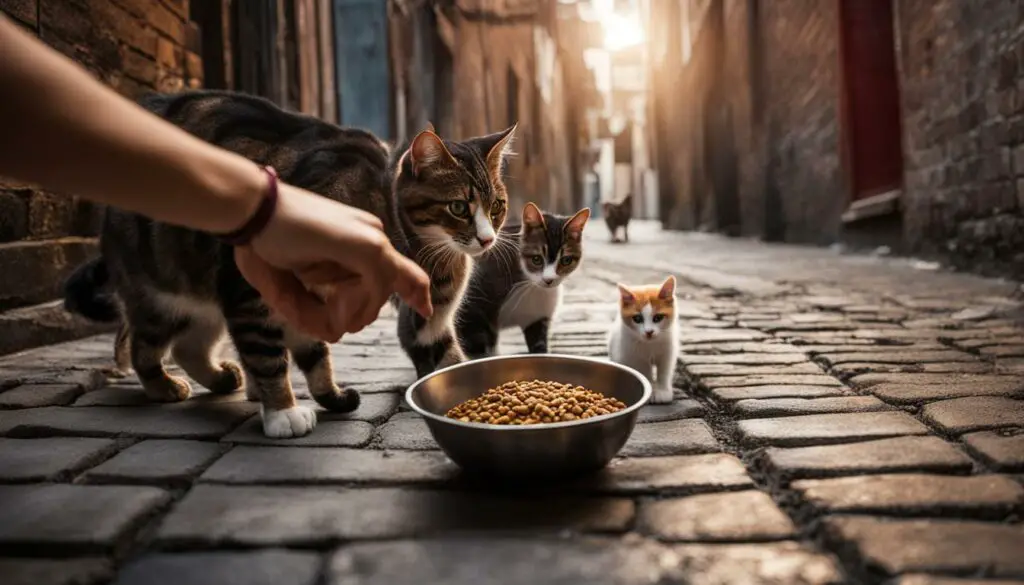Hi there, cat lovers! Today, I want to dive into the fascinating world of attracting stray cats. Whether you have a soft spot for these adorable felines or simply want to help them find their way home, understanding cat behavior and building trust is key. Join me as we explore the step-by-step process of attracting stray cats and making a positive impact on their lives.
Key Takeaways:
- Understanding the differences between stray and feral cats is crucial when attracting them.
- Observing their behavior and appearance can help determine whether a cat is stray or feral.
- Gaining the trust of stray cats requires patience, a calm approach, and using food as a tool.
- Building a positive relationship takes time, providing temporary shelter, and planning a rescue if necessary.
- Spaying/neutering, TNR programs, and providing care for community cats contribute to their welfare.
Understanding Stray and Feral Cats
When it comes to attracting stray cats, it is essential to understand the differences between stray and feral cats. Stray cats are typically former pets that have become lost or abandoned. They may approach people and tolerate human contact to some extent. Feral cats, on the other hand, are born in the wild and have little to no direct human interaction. They are generally fearful of humans and prefer to live in colonies or as solitary cats. Knowing these distinctions is crucial when trying to attract and interact with them.
Stray cats, despite their current circumstances, may still be open to human interaction. They may approach people, greet them with a raised head and tail, and exhibit signs of being lost or abandoned. Building trust with stray cats is a gradual process, and patience is key. On the other hand, feral cats are often more cautious and skittish around humans. They tend to keep their heads and tails low and have wide-open eyes, exhibiting defensive behavior when approached by humans.
Understanding the behavior and nature of stray and feral cats is the foundation for successful interaction and attraction. It allows us to tailor our approach and methods to gain their trust and ultimately help them. Taking the time to learn about them will enable us to provide the care and support necessary for their well-being.
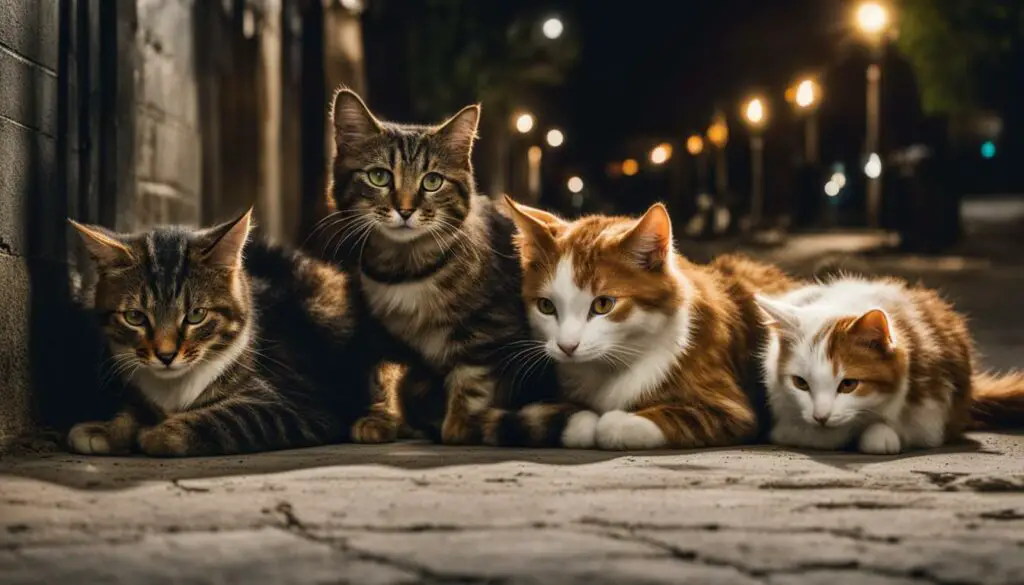
The Differences Between Stray and Feral Cats:
| Stray Cats | Feral Cats |
|---|---|
| Former pets that have become lost or abandoned | Born in the wild and have little to no direct human interaction |
| May approach people and tolerate human contact | Fearful of humans and prefer to live in colonies or as solitary cats |
| Show signs of being lost or abandoned | Exhibit defensive behavior when approached by humans |
Determining Whether a Cat Is Stray or Feral
Observing a cat’s behavior and appearance can help determine whether it is stray or feral. Stray cats may approach people and show signs of being lost or abandoned. They may greet humans with a raised head and tail, indicating a level of comfort with human interaction. In contrast, feral cats are typically defensive and fearful of humans. They may keep their head and tail low and their eyes wide open as a sign of caution. Understanding these behavioral cues can provide insight into whether a cat is stray or feral.
Additionally, paying attention to a cat’s physical appearance can also provide clues. Stray cats may have a more well-groomed and healthy appearance, whereas feral cats can appear more scruffy and unkempt due to living in the wild. However, it’s important to note that determining whether a cat is stray or feral may not always be straightforward, as there can be variations in behavior and appearance.
| Behavior | Stray Cats | Feral Cats |
|---|---|---|
| Approach to humans | May approach and tolerate human contact to some extent | Are typically fearful of humans and have little to no direct interaction |
| Head and tail posture | Raised head and tail when greeting humans | Head and tail low as a sign of caution |
| Appearance | May have a more well-groomed and healthy appearance | Can appear scruffy and unkempt due to living in the wild |
By observing both behavior and appearance, you can make a more informed assessment of whether a cat is stray or feral. However, it’s important to approach all cats with caution and respect, as each cat may have unique experiences and reactions to human interaction.
Gaining Trust with Stray Cats: Building a Positive Relationship
Building trust with stray cats is a delicate process that requires patience, dedication, and a calm approach. By following a few key steps, you can establish a positive relationship and earn the trust of these vulnerable feline friends.
One crucial aspect of gaining trust is to provide food and water for the stray cat. This creates a positive association and helps them feel comfortable in your presence. Start by placing the food at a safe distance and gradually move it closer to where you want the cat to be. Be consistent with the feeding routine to build trust and encourage the cat to approach you.
While it may be tempting to try and pet the stray cat right away, it’s important to let them approach you on their terms. Sudden movements or attempts to touch them too soon can undo the trust you’ve built. Instead, allow the cat to get used to your presence and gradually move closer over time. Remember, trust takes time to develop, so be patient and let the cat set the pace.
| Building Trust with Stray Cats | |
|---|---|
| Step 1: Provide food and water to create a positive association. | Step 2: Move the food closer to where you want the cat to be. |
| Step 3: Avoid sudden movements and let the cat approach you voluntarily. | Step 4: Be patient and allow the cat to set the pace. |

“Building trust with stray cats is a delicate process that requires patience and a calm approach.”
– Cat Lover
Using Food as a Tool to Attract Stray Cats
When it comes to attracting stray cats, food is a powerful tool. The enticing aroma of smelly food like tuna or canned cat food can help lure them out of hiding and create a positive association. Place the food in a safe and quiet area, away from potential dangers, and gradually move it closer to where you want the cat to be. Consistency is key – establish a feeding routine and stick to it. This will not only help build trust but also encourage the cat to approach you.

Using food strategically can also help with socializing shy or fearful stray cats. Start by placing the food at a distance where the cat feels comfortable. As the cat becomes more confident and familiar with your presence, gradually decrease the distance between you and the food. This gradual approach will help the cat feel at ease and build trust over time.
Remember, every cat is unique, and patience is key. Some cats may approach you right away, while others may take longer to feel comfortable. By using food as a tool and allowing the cat to approach you voluntarily, you can create a positive relationship and increase the chances of successfully attracting a stray cat.
Creating a Positive Relationship with Stray Cats
Building trust with stray cats is a gradual process that requires patience, understanding, and a gentle approach. It is important to remember that every cat is unique and may have different comfort levels when it comes to human interaction. Here are some steps you can take to create a positive relationship with stray cats:
- Provide a safe and quiet space: Create a calm and secure environment for the cat by offering a temporary shelter or a warm spot where they can feel safe and comfortable.
- Respect their boundaries: Give the cat time and space to approach you on their own terms. Avoid overwhelming them with sudden movements or attempts to pet them too soon. Let them set the pace of the interaction.
- Use positive reinforcement: Offer treats or rewards when the cat displays positive behavior, such as approaching you or allowing gentle petting. This helps create a positive association with your presence.
“Building trust with stray cats is a gradual process that requires patience, understanding, and a gentle approach.”
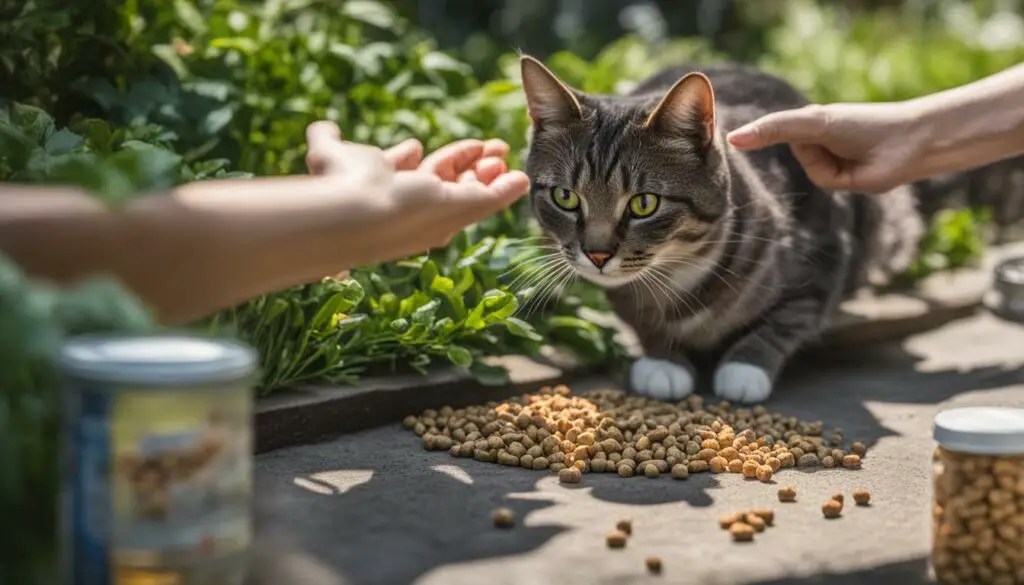
Additionally, engaging in quiet activities near the cat, such as reading a book or talking softly, can help them become more accustomed to your presence. The goal is to build a bond based on trust and mutual respect. Remember, every small step towards creating a positive relationship with a stray cat is a significant achievement.
Finding common ground
One way to establish a bond with a stray cat is to find common interests or activities that they enjoy. For example, you can try engaging in playtime with interactive toys or offering scratching posts for them to explore. These activities not only provide mental and physical stimulation but also serve as opportunities for you to spend time together and strengthen your bond.
| Activity | Benefits |
|---|---|
| Interactive play sessions | Helps build trust and confidence |
| Providing scratching posts | Redirects their natural scratching behavior away from furniture |
By engaging in activities that the cat enjoys, you can create a positive and enjoyable experience for both of you. Remember to always respect the cat’s boundaries and never force them to participate in activities they are not comfortable with.
Planning a Rescue for Stray Cats
When it comes to rescuing stray cats, careful planning and preparation are essential. It’s crucial to create a safe and stress-free environment for both you and the cat during the rescue process. Here are some steps to consider when planning a rescue:
- Gather the necessary supplies: Prepare a rescue kit that includes a cat carrier, gloves, a blanket or towel, and any other items you may need. Having all the necessary supplies on hand will make the process smoother and more efficient.
- Choose the right timing: Timing is key when it comes to capturing a stray cat. Plan the capture during a time when the cat is likely to be calm and relaxed. Avoid noisy or crowded areas that may increase stress levels.
- Position the carrier strategically: Place the carrier in a location where the cat feels comfortable and safe. Gradually acclimate the cat to the carrier by placing food, water, and a cozy blanket inside. Allow the cat to explore the carrier at its own pace.
- Use food as a lure: Food can be a powerful tool in attracting and capturing stray cats. Use smelly and enticing food to draw the cat closer to the carrier. Gradually move the food closer to the carrier to encourage the cat to enter.
Remember, patience and a calm approach are key during the rescue process. The goal is to create a safe and stress-free experience for both you and the cat. By following these steps and being prepared, you can increase the chances of a successful rescue operation.
“Rescuing stray cats requires careful planning and a gentle approach. By providing a safe and stress-free environment and using food as a lure, you can increase the chances of a successful rescue.” – Cat Rescue Expert
Table: Rescue Supplies Checklist
| Item | Quantity |
|---|---|
| Cat carrier | 1 |
| Gloves | 1 pair |
| Blanket or towel | 1 |
| Food and water | As needed |
| Leash or harness | 1 |
| First aid kit | 1 |
Having a well-stocked rescue kit is crucial for a successful cat rescue operation. Make sure you have all the necessary supplies to ensure the safety and well-being of the cat during the process.
Taking Care of Stray Cats After Capture
After successfully capturing a stray cat, the next step is to ensure their well-being and address any immediate medical concerns. It is essential to take the captured cat to a veterinarian for a thorough health check-up and evaluation. This step is crucial to assess the cat’s overall health, check for microchips, and address any immediate medical needs they may have.
During the veterinary check-up, the cat’s general health will be assessed, including their body condition, vaccination status, and any signs of illness or injury. The veterinarian may also perform tests to check for common parasites, such as fleas, ticks, and internal parasites like worms. If the cat is not already spayed or neutered, this is also an opportune time to discuss the importance of the procedure.
Quarantine may be necessary depending on the cat’s health status and any potential risks they may pose to other cats or animals in the household. It’s important to provide a safe and secure space for the cat during this period, ensuring they have access to food, water, and a comfortable resting area. Regular monitoring of the cat’s health and behavior is crucial during this time, and any concerning developments should be promptly addressed by a veterinarian.
| Benefits of Veterinary Check-up After Capture |
|---|
| Assesses overall health |
| Checks for microchips and potential owners |
| Addresses immediate medical needs |
| Provides necessary vaccinations |
| Determines spaying/neutering options |
Taking care of stray cats after capture involves prioritizing their health and well-being. By seeking professional veterinary care, ensuring quarantine when necessary, and addressing immediate medical needs, we can set the foundation for their successful transition into a safe and loving home.
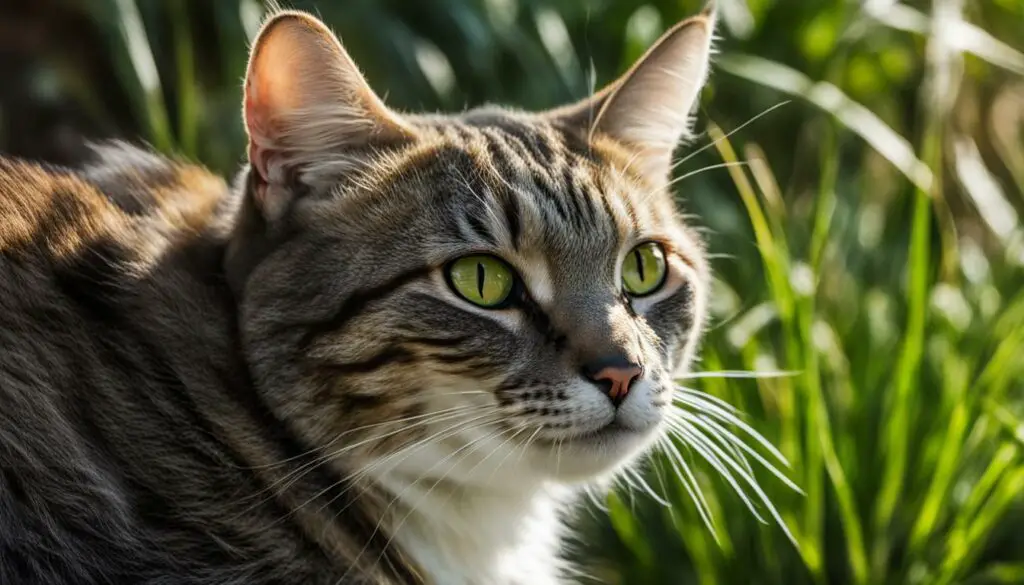
Finding Homes for Stray Cats
When it comes to stray cats, finding them suitable homes is essential for their well-being and happiness. If you come across a stray cat and suspect it may not have a home, there are steps you can take to help find its owner or find a new home for the cat.
If you believe the cat may have an owner, it’s important to try to locate them. Take a clear picture of the cat and knock on doors in the neighborhood to inquire if anyone recognizes the cat. You can also check for collars or microchips, which can provide valuable information about the cat’s ownership. Additionally, distributing flyers and posters in the area and utilizing social media and lost and found pet databases can help spread the word and increase the chances of reuniting the cat with its owner.
However, if it becomes apparent that the cat doesn’t have a home or its owner cannot be found, finding a suitable adoption or foster placement is crucial. Contact local animal shelters, rescue organizations, and foster networks to inquire about their available resources and assistance in finding the cat a permanent home. These organizations often have extensive networks and resources to help facilitate the adoption or foster process.
Remember, finding homes for stray cats requires patience and perseverance. It may take time to locate the owner or find the right adoption or foster placement. But with dedication and the help of local animal welfare organizations, we can ensure that stray cats are given the chance to live in a safe and loving environment.
The Importance of Spaying/Neutering and TNR Programs
When it comes to managing the cat population and ensuring their reproductive health, spaying/neutering and Trap-Neuter-Return (TNR) programs play a vital role. Spaying and neutering are essential in controlling the number of stray cats and preventing the potential problems associated with overpopulation. TNR programs, on the other hand, provide a humane and effective way to manage community cat populations.
Spaying and neutering cats help prevent unwanted litters and reduce the risks of certain health issues such as cancers, infections, and behavioral problems. By sterilizing cats, we can prevent the cycle of reproduction and ensure a healthier and more balanced cat population.
TNR programs involve trapping stray cats, neutering or spaying them, vaccinating them against diseases, and returning them to their original location. This approach has proven to be effective in reducing cat populations, preventing mating behaviors such as spraying and fighting, and minimizing the risks associated with uncontrolled breeding. TNR programs also help improve the overall welfare of community cats by providing them with necessary medical care and reducing the chances of them being euthanized.
| Advantages of Spaying/Neutering and TNR Programs | Benefits to Cat Population Control |
|---|---|
| Prevents unwanted litters | Controls and reduces stray cat populations |
| Reduces the risks of certain health issues | Prevents mating behaviors such as spraying and fighting |
| Improves the overall welfare of cats | Minimizes the risks associated with uncontrolled breeding |
By prioritizing spaying/neutering and implementing TNR programs, we can effectively control the cat population, reduce the burden on animal shelters, and enhance the well-being of stray and community cats. These efforts not only benefit the cats themselves but also contribute to a harmonious coexistence between outdoor cats and their human neighbors.
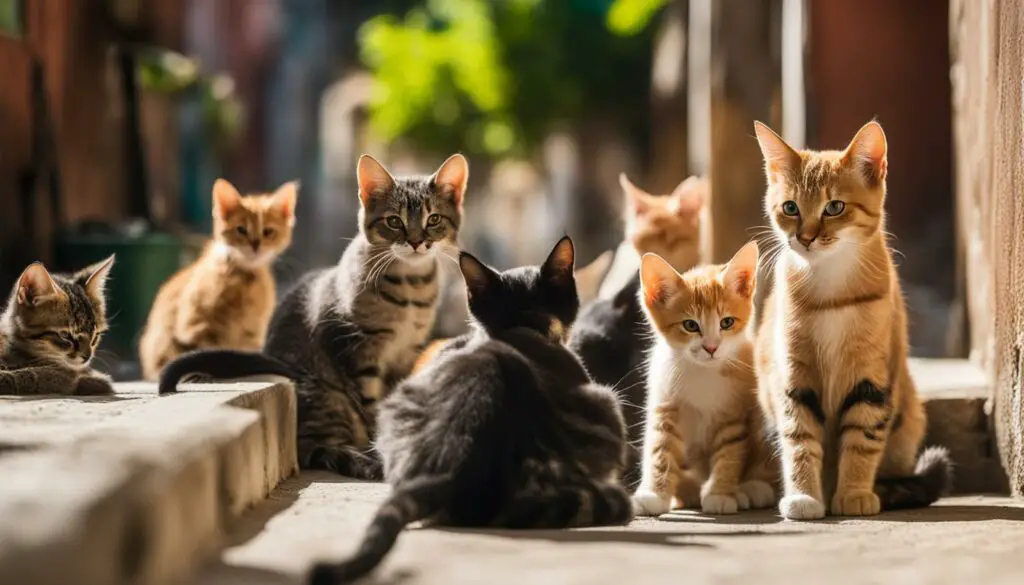
Providing Care for Community Cats
When it comes to outdoor cats, providing care is essential for their well-being. As caregivers, we play a crucial role in ensuring that these community cats have their basic needs met. This includes food, water, and shelter. Regular feeding not only helps to nourish them but also creates a bond between us and the cats.
It’s important to establish a consistent feeding routine, providing nutritious food that meets their dietary requirements. This helps to maintain their overall health and vitality. Feeding stations should be placed in a safe and quiet area, away from potential dangers or disturbances. By doing so, we create an inviting environment for the cats to come and enjoy their meals.
In addition to food, water is another vital resource for community cats. Clean, fresh water should be provided in a separate bowl or container near the feeding station. This helps to keep the cats hydrated, especially during hot weather or in dry climates.
| Outdoor Cat Care | Cat Feeding | Cat Shelter |
|---|---|---|
| Regular feeding routine | Nutritious food | Providing safe and cozy spaces |
| Consistent access to clean water | Separate water source | Protection from the elements |
| Monitoring food intake | Adjusting portion sizes as needed | Insulated shelters for warmth |
In addition to food and water, providing suitable shelter is crucial for the well-being of community cats. These shelters should offer protection from the elements, such as rain, wind, and extreme temperatures. Insulated shelters with cozy bedding help to keep the cats warm during colder months. It’s important to regularly clean and maintain the shelters to ensure they remain a safe and comfortable space for the cats.
By providing care for community cats through regular feeding, access to clean water, and suitable shelter, we can significantly improve their quality of life. Our efforts as caregivers help to create a more compassionate and supportive environment for these cats, while also promoting responsible cat ownership in our communities.
Addressing Concerns and Misconceptions About Outdoor Cats
As a cat lover and advocate for outdoor cats, I understand that there are concerns and misconceptions surrounding their presence in our neighborhoods. However, it’s important to address these concerns with accurate information and promote a better understanding of cat behavior and their impact on the environment. By doing so, we can foster a more harmonious relationship between outdoor cats and the communities they inhabit.
To begin with, one common concern is the potential for cat-human conflict. While it is true that outdoor cats may occasionally interact with humans in ways that some may find undesirable, it’s essential to remember that cats have their own unique behaviors and instincts. They may exhibit territorial behavior, such as marking their territory or engaging in hunting activities, which can be misunderstood as aggressive or disruptive. By educating ourselves about cat behavior and being mindful of their needs, we can minimize potential conflicts and promote peaceful coexistence.
Another misconception is that outdoor cats have a detrimental impact on local wildlife populations. While it is true that cats are natural hunters, research has shown that their impact on wildlife populations is complex and varies depending on numerous factors, including the cat’s hunting skills and the local ecosystem. It’s important to keep in mind that well-fed and properly cared for outdoor cats are less likely to engage in hunting behavior. Implementing responsible cat ownership practices, such as spaying/neutering and providing enrichment, can help reduce hunting instincts and mitigate any potential negative effects on local wildlife.
By addressing concerns and misconceptions about outdoor cats, we can work towards a more inclusive and compassionate approach to community cat management. This involves implementing effective strategies like Trap-Neuter-Return (TNR) programs, which have been proven to be successful in controlling cat populations and improving their overall welfare. Additionally, promoting responsible cat ownership practices, such as providing proper veterinary care and enrichment, ensures that outdoor cats can lead healthy and fulfilling lives while minimizing any potential impact on the environment.

Outdoor Cat Concerns at a Glance
| Concerns | Reality |
|---|---|
| Cat-human conflict | Understanding cat behavior and providing appropriate care can foster peaceful coexistence. |
| Impact on wildlife | The impact of outdoor cats on wildlife populations is complex and depends on various factors. |
| Community cat management | Implementing effective strategies like TNR programs ensures responsible and compassionate management. |
By addressing concerns, promoting education, and engaging in responsible cat management, we can create a more inclusive and compassionate future for outdoor cats. With the right knowledge and practices, we can support the well-being of our feline friends while maintaining a balance with the environment and our communities.
Protecting Cats and Wildlife
When it comes to outdoor cats and wildlife, there is a delicate balance that needs to be struck. On one hand, outdoor cats have a natural instinct to hunt and may prey on local wildlife, which can have a negative impact on local ecosystems. On the other hand, simply removing cats without implementing comprehensive management strategies is not a sustainable solution.
One effective approach to mitigating the impact of outdoor cats on wildlife populations is through Trap-Neuter-Return (TNR) programs. TNR involves trapping stray cats, sterilizing them, vaccinating them, and returning them to their original location. This helps to control the cat population and prevent behaviors associated with mating, while also ensuring that the cats are not euthanized.
Another important aspect of protecting both cats and wildlife is responsible cat ownership. This includes keeping cats indoors whenever possible, especially during peak hunting times, and providing them with plenty of mental and physical stimulation to help satisfy their natural instincts. Outdoor enclosures or “catios” can also be a great way to allow cats to safely experience the outdoors while protecting wildlife.
| Benefits of TNR Programs and Responsible Cat Ownership | Importance of Wildlife Conservation |
|---|---|
| Controls cat population and prevents behavior associated with mating | Preserves biodiversity and the natural balance of ecosystems |
| Improves the overall welfare of outdoor cats | Protects vulnerable and endangered species |
| Prevents the euthanasia of healthy cats | Reduces predation on wildlife |
Ultimately, finding a balance between protecting cats and wildlife requires a combination of TNR programs, responsible cat ownership, and efforts to preserve and restore wildlife habitats. By implementing these strategies, we can promote the well-being of outdoor cats while also safeguarding the natural environment for the benefit of both feline and wildlife populations.

The Welfare of Outdoor Cats
When it comes to the welfare of outdoor cats, it’s important to consider their health, their interaction with humans, and their socialization. Providing proper care for these cats can significantly improve their overall well-being and quality of life.
Outdoor Cat Health: Ensuring the health of outdoor cats is crucial. Regular veterinary care, including vaccinations and check-ups, can help prevent and address any potential health issues. Additionally, providing them with a well-balanced diet and access to clean water is essential for their overall physical health.
Cat-Human Interaction: The interaction between outdoor cats and humans can greatly impact their welfare. While some outdoor cats may be more socialized and comfortable around humans, others may be more wary or fearful. It’s important to approach outdoor cats with patience and respect, allowing them to dictate their level of interaction.
Cat Socialization: Socialization plays a crucial role in the welfare of outdoor cats. Cats that have been properly socialized tend to be more confident, adaptable, and less stressed. Providing them with positive experiences and gentle interactions can help improve their socialization skills and overall well-being.
Table: Benefits of Welfare Practices for Outdoor Cats
| Welfare Practice | Benefits |
|---|---|
| Regular veterinary care | Prevents and addresses health issues |
| Proper nutrition and hydration | Improves physical health and well-being |
| Respectful and patient interaction | Builds trust and reduces stress |
| Positive socialization experiences | Improves adaptability and confidence |
“Taking care of the welfare of outdoor cats involves addressing their health needs, facilitating positive interactions with humans, and promoting socialization. By implementing these practices, we can contribute to the overall well-being and happiness of outdoor cats.”
In summary, prioritizing the welfare of outdoor cats involves ensuring their health through regular veterinary care, fostering positive interactions with humans with patience and respect, and promoting socialization for improved adaptability. By implementing these practices, we can create a safer and more compassionate environment for outdoor cats, ultimately enhancing their overall quality of life.

Conclusion
As a cat lover and advocate for their welfare, I understand the importance of providing care and support to stray and outdoor cats. By implementing effective management strategies and prioritizing their well-being, we can create a more harmonious relationship between these feline friends and our communities.
Stray cat care is essential to ensure their health and happiness. By providing food, water, and shelter, we can improve their overall welfare. Regular veterinary care, including spaying/neutering and vaccinations, is crucial to prevent overpopulation and maintain their reproductive health.
Community cat management is a key aspect of outdoor cat welfare. Programs like Trap-Neuter-Return (TNR) not only control cat populations but also reduce behavioral issues associated with mating. Additionally, responsible cat ownership practices, such as regular feeding and providing dedicated shelter, are vital to their well-being.
By prioritizing stray cat care, implementing community cat management programs, and promoting responsible cat ownership practices, we can create a safer and happier environment for both cats and humans. Let’s continue to work together to ensure the outdoor cat welfare and build stronger bonds between our communities and these amazing feline companions.
FAQ
What is the difference between a stray cat and a feral cat?
Stray cats are usually former pet cats that have become lost or abandoned, while feral cats are born in the wild and have little to no direct human interaction.
How can I determine whether a cat is stray or feral?
Observing their behavior and appearance can give you some clues. Feral cats are usually defensive, with their head and tail low and eyes wide open, while stray cats may approach people, greet them with a raised head and tail, and show signs of being lost or abandoned.
How can I build trust with a stray cat?
It takes patience, dedication, and a calm approach. Start by providing food and water to attract them and create a positive association. Gradually build a positive relationship by moving closer to the cat while it eats and avoiding sudden movements. Be patient and allow the cat to approach you voluntarily.
What kind of food can I use to attract stray cats?
Smelly food like tuna or canned cat food can be used to lure them out of hiding. Place the food in a safe and quiet area and gradually move it closer to where you want the cat to be. Keep the feeding routine consistent to build trust and encourage the cat to approach you.
When should I consider planning a rescue for a stray cat?
If you’ve gained the cat’s trust and it is in need of medical attention or a safe shelter, it may be necessary to plan a rescue. Prepare a rescue kit with a cat carrier, gloves, and other necessary supplies. Position the carrier close to the cat and gradually acclimate them to it by placing food, water, and a blanket inside. Plan the capture timing to ensure a calm environment and minimal stress for the cat.
What should I do after capturing a stray cat?
It’s important to take them to a veterinarian for a thorough health check-up. This includes assessing their overall health, checking for microchips, and addressing any immediate medical needs. If quarantine is necessary, provide a safe and secure space for the cat while monitoring their health and well-being.
How can I find the owner of a stray cat?
If you suspect a stray cat may have a home, take steps to find its owner. Take a picture of the cat, knock on doors in the neighborhood, and check for collars or microchips. Distribute flyers and posters in the area and use social media and lost and found pet databases to spread the word. If the cat doesn’t have a home, consider finding a suitable adoption or foster placement.
Why is spaying/neutering and TNR important for stray cats?
Spaying and neutering are crucial in managing stray cat populations. Trap-Neuter-Return (TNR) programs are an effective strategy to control cat populations and improve their overall welfare. TNR involves trapping stray cats, sterilizing them, vaccinating them, and returning them to their original location. This approach helps reduce overpopulation and prevents behaviors associated with mating.
How can I provide care for community cats?
Community cats rely on caregivers who provide them with food, water, and shelter. Regular feeding and providing dedicated shelter can significantly improve their well-being and reduce their impact on the environment. Caregivers also play a crucial role in monitoring the cats’ health, providing medical care when needed, and participating in TNR efforts.
What can I do to address concerns and misconceptions about outdoor cats?
Understanding the behavior of community cats and implementing effective management strategies like TNR can help mitigate any negative impacts they may have. Education and awareness about their needs and behaviors can also lead to more harmonious coexistence between outdoor cats and their human neighbors.
How can we protect both cats and wildlife?
The issue of cat predation on wildlife is complex, and there are no easy solutions. Removing cats without implementing comprehensive management strategies is not effective in the long term. TNR programs and responsible cat ownership, combined with efforts to protect wildlife habitats, can help minimize the impact of outdoor cats on wildlife populations.
How can I ensure the welfare of outdoor cats?
While outdoor cats face certain risks, they can also live healthy and fulfilling lives with proper care. Providing them with food, water, shelter, and regular veterinary care can significantly improve their well-being. TNR programs and responsible cat ownership practices contribute to the overall welfare and health of outdoor cats.

